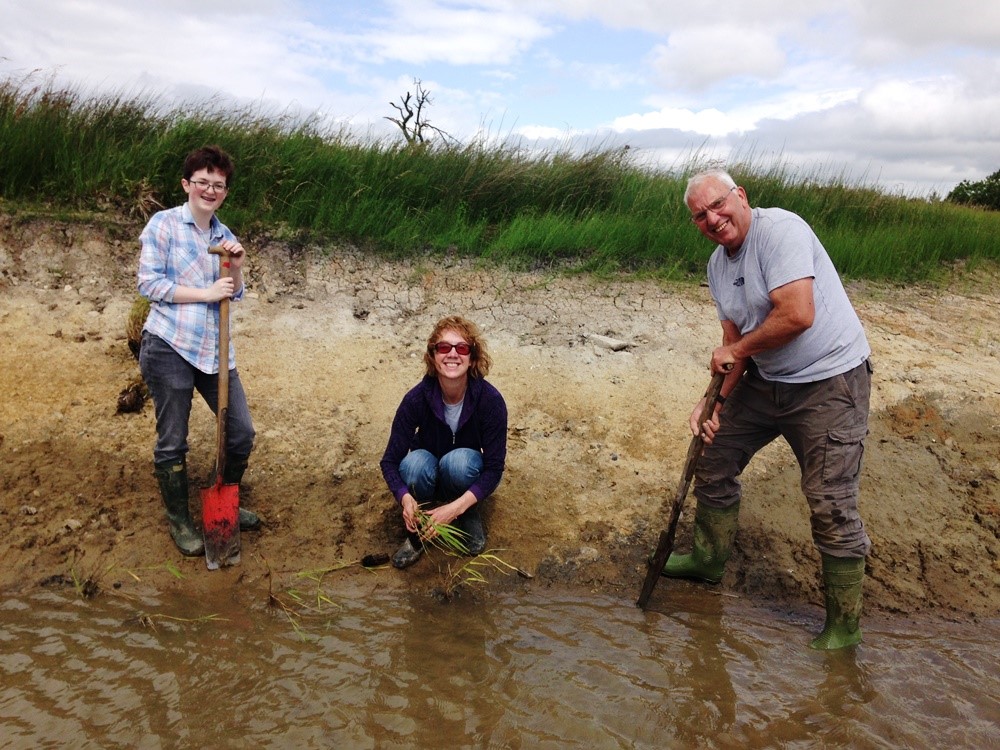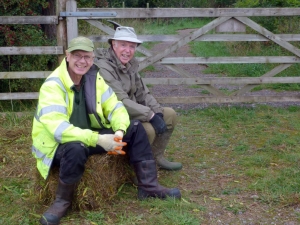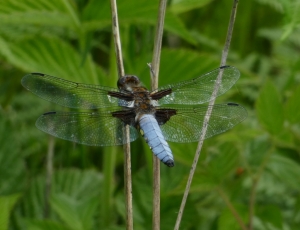Blog Archive (9) Posts Made in October 2022
Autumn at Foxglove
Friday, October 28th 2022
Autumn started then slowed but it is now almost as it should be. The trees are changing to their autumn dress. The Sycamore Avenue, which should really be Maple Avenue or even Lime Avenue, is showing the golds and yellows of the season.

Further along Larch is also changing colour as its needles begin to drop. Soon the path will be covered in orange needles. Up in the Larch trees flocks of finches and tits are feeding on the seeds of the cones.

This year has been a bumper year for fungi with nearly 100 recorded by the species team, this month alone. Although some are 'going over' there are still plenty to see. This is nearly a fairy ring!

Out on the moor small birds are flitting and were identified as Stonechats, a male and either a female or youngster. When the records were checked Stonechats were first observed during June 2004, with no more sightings until March and April 2013 and finally January 2015. It is lovely to see these birds making an appearance after nearly seven years absence.

The reserve managers and volunteers are now into the long list of winter work, no matter what the weather. This week brash and reeds have been removed, repairs have been carried out and small nest boxes have been emptied ready for next spring, just to name a few of the tasks. Many thanks for all of your hard work, which is really valued.
The Redwings are Here!
Monday, October 24th 2022
Last week a Redwing was ringed at Portland but none had been seen in our area. Then suddenly we were hearing of flocks flying over and then they arrived in Foxglove ready to feast on the Hawthorn berries.
Although breezy, parts of the reserve were sheltered so some nets were raised on Saturday and it was not long before the first Redwing was caught and ringed. The speckled breast and red feathers under the wing could be easily seen in this photograph.

By the end of the morning 29 Redwings had received their rings.
Thank you to the volunteers who came in early on Saturday to help with the ringing.
Species Update
Friday, October 21st 2022
Foxglove Covert LNR is 30 this year. We had the brilliant idea that we would try to find 30 new species to add to our Species List.
_1.png)
By the time the Bioblitz day arrived in August we had manged 13 species, including trees, moss and a bird, the Avocet. The pair only stayed for a couple of days but we hope they will drop in again next year and hopefully bring some friends!

Although we still had several species to go to reach our target we were not downhearted as the moth morning always gives several new species. The traps were put out on the 5th, which just happened to be the coldest night of the previous two weeks so the catch was low but we did add another two species to the list.
August 6th saw the Bioblitz day. Sunny and warm, visitors and experts wandered around the reserve, recording what they saw and what they caught in nets. The highlight of the day was during the butterfly walk when several of our butterflies were recorded and after close examination through binoculars and of photographs a Silver Washed Fritillary was seen. Excitement! There was even more excitement when one of the Species Team realised that she had seen this butterfly a few days before, so it hadn't just dropped in for the day. It was seen several times after this. Along with our resident Dark Green Fritillary the caterpillars feed on Common Dog Violet of which there are plenty at Foxglove.

Once our excitment had calmed a little there was another shout, a blue, which had been missing from our list during the walk. Photos taken and then a realisation that it was not a Common Blue but a Brown Argus. Another new species.

So a few more species added to the list by the end of the day, but no where near our 30. So we waited for the results to come from our experts and they did us proud, with 36 new species being recorded, bringing the grand total to 51.
However things have not stopped there. Fungi have had an exceptional year and new species have been recorded. Dr C Fletcher visited Foxglove recently to look for leaf mining lepidoptera and he found a few! He added 20 new species to our list which stands around 80 now!
A huge thank you to the reserve managers, volunteers, the Species Team, visitors and our experts who gave their time so willingly in August and beyond.
I have suggested that we may have time to get to 100 by the end of the year?
A Moth Blog but the Birds have squeezed in again!
Thursday, October 20th 2022
When the ringing team travelled North to Cape Wrath the signal was erratic and photos often did not arrive. However there is a good connection from Portland and three photos of beautiful birds have just dropped into my Inbox.
At Foxglove we are patiently awaiting out first Redwing, but one has already been ringed down at Portland. You can definitely see the red colouration on this bird.

The Stonechat is another bird that was ringed.

And finally a Whinchat. The Whinchat visits during the summer and is a passage migrant. They breed in upland areas of northern and western Britain with a few in Ireland. It winters in central and southern Africa. Whinchat numbers in Britain more than halved between 1995 and 2008, the cause(s) being unknown.

Now back to moths! This is one of the egg trays from the moth trap.

Palpita vitrealis is another migrant moth, from southern Europe, with the common name of Olive-tree Pearl or Jasmine Moth. It can sometimes be seen feeding from Ivy and Buddleia. Its flight season is from June to December, but it is mainly seen along the southern coastal counties from late summer into autumn.

Spot the moth! A well camouflaged moth.

Thanks to the team for sending these photos. They start on their return journey tomorrow.
Portland and Pumpkins
Wednesday, October 19th 2022
The weather at Portland is rather windy so the mist nets are unable to be raised but they are still catching birds using other methods. This photograph shows Hayley wrapped up against the weather with the rough sea behind her.

Some photos have just arrived in my Inbox. A view showing how brisk the wind is coming over the sea, with black clouds overhead.

The bird ringing 'room' is a little different to Foxglove and even the Crater. At least it looks sheltered.

A bird that we don't see around Foxglove is this Rock Pipit. It is larger than our Mipits but smaller than a Starling. Their diet includes insects, beetles, small fish and shellfish. They are resident and breed around the rocky coasts of the UK. Some birds fly from Norway to spend the winter.

Another bird ringed today was a Black Redstart. With fewer than 100 breeding pairs in the UK, the Black Redstart is on the Red List of Birds of Conservation Concern. It is also listed as a Schedule 1 species on The Wildlife and Countryside Act, which means a special license is needed by the bird ringers if these birds are to be ringed during the breeding season.

Meanwhile back at Foxglove the Species Team of volunteers showed off other skills by decorating the pumpkins, kindly donated by Tesco. They will be ready for the Pumpkin Trail next week.

The Species Team had time to go for a wander around the reserve and listed over 55 fungi still fruiting. (This information again, has just dropped into my inbox!) It has been an amazing year for fungi. Thanks to the Species Team for identifying them over the last few weeks and adding to our list of species.
Portland Bill Bird Observatory
Tuesday, October 18th 2022
Some of the Swaledale Ringing group are visiting Portland Bill to experience another bird ringing site and to ring some species that don't venture into Foxglove. The ringers have recorded Stonechats out on the training area. This is a juvenile male.

A tiny bird that we don't see was this Firecrest. The highlight of the day so far!

As well as ringing birds the moth trap is set and the moths recorded. From the information we have been sent they catch some different moths to those at Foxglove, which is to be expected. This moth is a Flame Brocade which became extinct in this country in the 19th centuary and is now only found in the Channel Islands. It is an migrant and is caught along the sounthern shores, mainly from Hampshire westwards.

Another insect to drop in on the ringers was a wasp, possibly a Black Slip Wasp.

Whilst staying in Portland the ringers are living in the old lighthouse.

If you wish to follow the Porland Bird Observatory blog then follow this link http://www.portlandbirdobs.com/
Mipit Migration
Wednesday, October 12th 2022
Meadow Pipits, affectionately known as 'Mipits', are small birds with brown streaky plumage and white outer tail feathers that can be clearly seen in flight. They can be distinguished from the similar looking Tree Pipit by their longer hind claw and slighter bill.

Meadow pipits feed mostly on invertebrates and are the most common songbird of upland areas. During late summer and early autumn, they migrate south from their upland breeding grounds. Members of the Swaledale Ringing Group have been out and about in the Pennines using mist nets to catch and ring these birds as they pass through. Over 200 individuals have been ringed so far this year. Thank you to everyone involved in this important conservation project.
Understanding Fungi
Saturday, October 8th 2022
Today is UK Fungus Day; an annual celebration of fungi which is an open invitation to everyone in the UK to experience and appreciate the wonder of fungi and to find out more about these fascinating organisms. Often described as the 5th kingdom, fungi are neither plant nor animal, and our knowledge of their biology and ecology is increasing all the time. They are incredibly important to the functioning of almost all ecosystems on earth. This autumn the fungi at Foxglove are spectacular and an event was held to learn more about them.
Species Volunteer Chris led a guided walk around the reserve to discover some of the fruiting bodies that were on display. The morning began briefly in the classroom where Chris explained the role of fungi in the ecosystem and how some are parasites, others rotters and recyclers and others mycorrhizal. The group then headed outdoors to identify different species and discuss their morphology.
Within a few metres of the Field Centre there was plenty to see. Turkeytail is a very colourful fungus and was once popular as a table decoration; at one time, it was even used to decorate hats!
Lumpy bracket was also on an old stump within a stone's throw from the Visitor Centre. It is found in woodland exclusively growing on dead deciduous wood, of which it favours beech.
Younger members of the group discovered a familiar species; King Alfred's cakes growing on Ash trees.They are also known as 'cramp balls' as it was believed that carrying them would protect people from attacks of cramp. King Alfred lived in the 9th century when parts of Britain had been overrun by Vikings. The story goes like this: Trying to escape them, he took refuge in the home of a peasant woman who asked him to watch over her cakes, baking by the fire. He let them burn and was scolded by the woman for his negligence. It is said that embarrassed and ashamed, he scattered the cakes to get rid of the evidence. As the fungus looks like small, burnt cakes, especially as they get older, the name King Alfred’s cakes went into common use.
Chris cut one in half to demonstrate that when broken they reveal a silver and black rings inside. The rings are similar to growth rings on a tree and each concentric circle represents a year’s growth. This also explain where the Latin name comes from – Daldinia concentrica.
Small stagshorn was a colourful find on a rotting log by the carpark.
The group then made their way to the woodland where there has been an incredible show of Fly Agaric. Chris described how the mycelium of fly agaric often forms a symbiotic relationship with the trees around it, wrapping around the roots and supplying them with nutrients taken from the soil. In exchange, the fungus receives sugars produced by the trees. We also learned that although poisonous to people they are a favourite food of Reindeer and that herders often lay a trail of them to lead their herd back home!
Up on the green route other highlights included puffballs…
False Saffron Milkcaps, Purple Russulas,....
...Shaggy Parasols and…
...Plums and Custard!
The English names were used but latin ones were discussed too. Back near the centre Elfin Saddles were found by a pathway. This is a slightly toxic but very unusual mushroom, one of the spore shooters that fire their spores out of their wrinkled caps rather than drop them from underneath.
Identifying mushrooms isn't easy especially as they can change their shape very quickly like these inkcaps.
A shappy inkcap was taken back to the classroom and placed on a plate so that the ink could drain out from it.
Two of our young supporters demonstrated how the ink can be put to good use!
The resulting artwork was very impressive and was most definitely inspired by the morning's walk!
It was a great end to a lovely morning.
Our sincere thanks to Chris for taking time to share her vast knowledge and to all of the people who joined in and made it so worthwhile.
Bilberry Bumblebees, Bunting, Biscuits, Bakes and Bombs!
Sunday, October 2nd 2022
Yesterday was a fun filled day at the reserve to celebrate the Great Big Green Week and to raise awareness about the rare Bilberry Bumblebee that we hope to attract to Foxglove in the near future. The Bilberry Bumblebee is a particularly attractive bumblebee, with bright yellow bands on the thorax and a rich orange-red tail covering around two-thirds of the abdomen. It is a localised and declining species, found almost exclusively on moorland in association with stands of Bilberry.
As there are no recorded Bilberry Bumblebees at the reserve yet there was a treasure trail in the picnic area and those that spotted the Bilberry Bee on a wooden disc were rewarded with a chocolate bee! Slates that had been beautifully decorated by local scout groups were placed along the easy access trail for people to spot as they enjoyed the autumn sunshine. There were lots of hands-on activities for all ages; the messy ones were done outside (until it became too windy) and included making leaf bunting, wildflower seed bombs and solitary bee hotels.
Indoors, local beekeeper Alison showed people how to make a beeswax candle.
Children's activities indoors also including making bee puppets, masks and wooden medals.
Cath from the Yorkshire Dales Millenium Trust was on hand to talk about bumblebee surveys and to give tips on identifying the different bumblebee species.
This species is very rare!
Special thanks go to Lizzie Rumble (RSPB volunteer) who not only organised the day but baked enough cakes and biscuits to keep everyone going!
Thank you too to everyone who made the day possible from planning and running activities to baking, serving teas and washing up. We are very grateful to all of the organisations who were involved; the RSPB, Whashton Wildlife and the YDMT and to the Co-op for donating wildflower seed cards.
Not forgetting all of the generous support from the members of public who came along on the day. Please put any photographs that you have from the event on our Facebook page and keep an eye out on our events page as there will be a Bilberry planting day coming up soon to create the perfect habitat to attract the Bilberry Bumblebee.






























